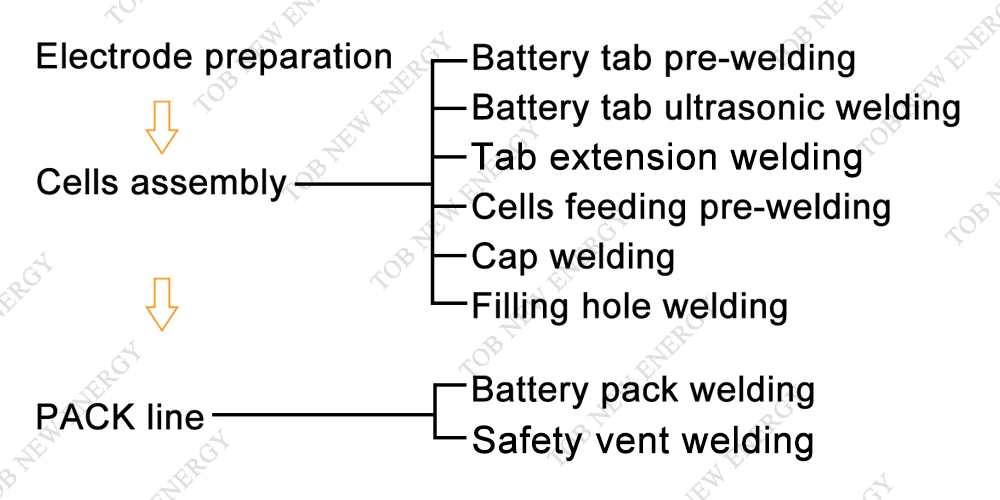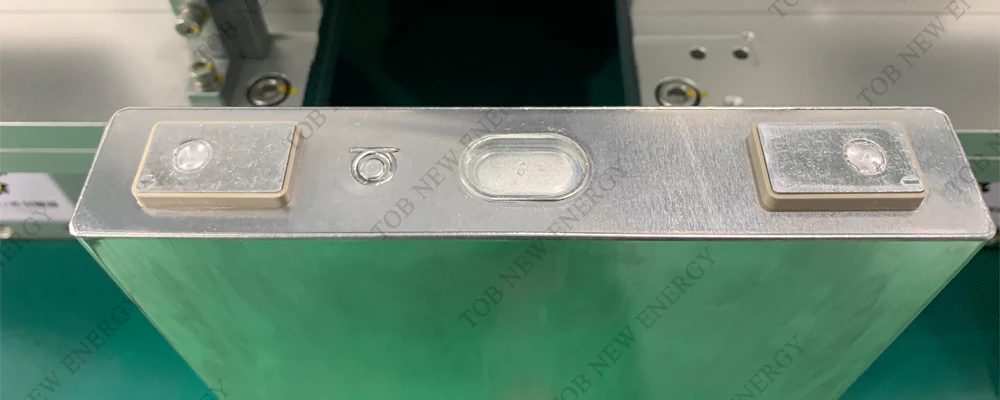Whether prismatic cells or cylindrical cells, welding is one of the important processes in battery production. In the lithium battery production line, the production section of the welding process is mainly concentrated in the cells assembly and PACK line section, see the figure below:

Brief description of welding process details
1. Safety vent welding
The safety vent, also known as the pressure relief valve, is a thin-walled valve body on the top cover of the battery. When the internal pressure of the battery exceeds the specified value, the safety vent ruptures and releases the pressure to prevent the battery from bursting. The safety vent has an ingenious structure. It usually uses laser welding to fix two aluminum metal sheets of a certain shape. When the internal pressure of the battery rises to a certain value, the aluminum sheet breaks from the designed groove position to prevent the battery from further expansion and explosion. Therefore, this process has extremely strict requirements on laser welding technology. The weld seam is required to be sealed and the heat input is strictly controlled to ensure that the damage pressure value of the weld seam is stable within a certain range (generally 0.4~0.7MPa). Too large or too small will have a great impact on the safety of the battery.
2. Terminal welding
The terminals on the battery cover plate are divided into positive and negative terminals. The function of the terminals is also divided into internal and external connections. The internal connection is the welding of the battery tabs to the terminals. The external connection is the welding of the battery terminals through the connecting strips to form series and parallel circuits to form a battery pack.
The battery terminals generally use aluminum for the positive electrode and copper for the negative electrode, and usually use a riveted structure. After the riveting is completed, welding is performed, usually a circle with a diameter of 8mm. When welding, as long as the tensile force and conductive properties of the design requirements are met, fiber lasers or hybrid welding lasers with good beam quality and uniform energy distribution are preferred. Use fiber laser or hybrid welding laser for welding. It can realize the stability of aluminum-aluminum structure welding and copper-copper structure welding of electrical terminals, reduce spatter, and thereby improve the welding yield.
3. Tab extension welding
The tab extension sheet is a key component that connects the battery cover and the battery jelly roll. It must also take into account the overcurrent, strength and low spatter requirements of the battery. Therefore, during the welding process with the cover, there needs to be sufficient weld width, and it is necessary to ensure that no particles fall on the battery jelly roll to avoid battery short circuit. Copper, as the negative electrode material, is a high-reflective material with low absorption rate and requires higher energy density during welding.
4. Cans sealing welding
The casing materials of power batteries include aluminum alloy and stainless steel. Among them, aluminum alloy is used most, and a few use pure aluminum. Stainless steel is the material with the best laser weldability, especially 304 stainless steel. Whether using pulse or continuous laser, welds with good appearance and performance can be obtained. Using continuous laser to weld thin-shell lithium batteries can increase the efficiency by 5 to 10 times, and the appearance and sealing properties are better. Now, in order to pursue faster welding speed and more uniform appearance, most companies have begun to use hybrid welding and annular light spot to replace the previous low-speed single fiber welding. At present, the welding speed of most companies' mass production lines has reached 200mm/s. For the low-speed fiber optic welding lines of some manufacturers, in order to ensure the stability of the weld bead, the general mass production speed is 70mm/s.

5. Sealing nail welding
Sealing nails (filling hole caps) also come in many forms, and their shape is usually a round cap with a diameter of 8mm and a thickness of about 0.9mm. The basic requirement for welding is that the withstand pressure value reaches 1.1MPa, and there should be no pinholes, cracks or explosion points. As the last process of battery cells welding, the yield of sealing nail welding is particularly important. Due to the presence of residual electrolyte during welding of sealing nails, defects such as explosion points and pinholes will occur. The key way to suppress these defects is to reduce the heat input. The use of laser welding can greatly improve stability and compatibility, thus greatly improving the yield rate.
6. PACK Busbar welding
The battery module can be understood as a combination of lithium-ion cells connected in series and parallel, with a single battery monitoring and management device installed. The structural design of the battery module often determines the performance and safety of a battery pack. Its structure must support, fix and protect the battery cells. At the same time, how to meet overcurrent requirements, current uniformity, how to control the cell temperature, and whether the power can be cut off in case of serious abnormalities to avoid chain reactions, etc., will all be the criteria for judging the quality of battery modules. Since laser welding between copper and aluminum tends to form brittle compounds that cannot meet the usage requirements, ultrasonic welding is usually used. In addition, copper and copper, aluminum and aluminum are generally laser welded. At the same time, because both copper and aluminum conduct heat very quickly and have very high laser reflectivity, and the thickness of the tab extension sheet is relatively large, a higher-power laser is required to achieve welding.